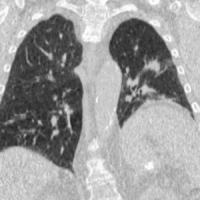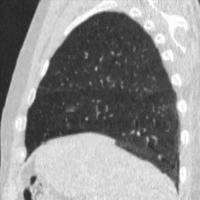Physics:4DCT
Four-dimensional computed tomography (4DCT) is a type of CT scanning which records multiple images over time. It allows playback of the scan as a video, so that physiological processes can be observed and internal movement can be tracked. The name is derived from the addition of time (as the fourth dimension) to traditional 3D computed tomography. Alternatively, the phase of a particular process, such as respiration, may be considered the fourth dimension.[1]
Fluoroscopy is a similar technique to 4DCT, however it refers to the introduction of a time element to 2D planar radiography, rather than to 3D CT.[2][3][4][5]
Applications
Radiotherapy
4DCT is used in radiation therapy planning to reduce doses to healthy organs such as the heart or lungs. Most radiation therapy is planned using the results of a 3D CT scan. A 3D scan largely presents a snapshot of the body at a particular point in time, however due to the time of the acquisition, in which the patient is likely to have moved in some way (even if only breathing), there will be an element of blurring or averaging in the 3D scan.[6] When it comes to treatment planning, this motion can mean there is less accuracy in the positioning of treatment beams, and reduce the likelihood of a repeatable set-up on the linear accelerator when it comes to treatment.[7]
To minimise physical movements of the patient, some sort of immobilisation is typically used. To overcome physiological motion, such as breathing, 4DCT acquires images at a range of times and positions, allowing the extent of motion to be visualised (e.g. from maximum inspiration to maximum exhalation). The treatment plan can then be designed with a knowledge of the full range of possible positions of important organs, and the tumour (target) itself.[8]
4DCT will usually involve a gating technique, such as breathing tracking, so that image acquisition is automatically triggered at set points.[9] This gating can also be applied at treatment, where the radiotherapy beam is only switched on at certain points in the breathing cycle (as in the deep inspiration breath-hold technique).[10]
Diagnostic radiology
4DCT has started to be used for diagnostic radiology procedures, for example looking at joint problems, the cardiac cycle and parathyroid washout of contrast. Downsides of 4DCT for diagnostic purposes include large and complex datasets, and increased radiation dose to the patient.[11]
Reconstruction methods
4DCT aims to visualise the temporal dynamics of a 3D sample with a sufficiently high temporal and spatial resolution. Successive time frames are typically obtained by sequential scanning, followed by independent reconstruction of each 3D dataset. Such an approach requires a large number of projections for each scan to obtain images with sufficient quality (in terms of artefacts and SNR). Hence, there is a clear trade-off between the rotation speed of the gantry (i.e. time resolution) and the quality of the reconstructed images. Motion vector based Iterative Techniques are available which reconstruct a particular time frame by including the projections of neighbouring time frames as well. Such a strategy allows to improve the trade-off between the rotation speed and the SNR. [12]
For fluid dynamics, specialized reconstruction algorithms have been developed that model the attenuation course throughout time.[13] An example of such fluid dynamics is perfusion CT in which the propagation of contrast agent is modelled and simultaneously estimated with the CT images. [14]
References
- ↑ Cox, James D.; Chang, Joe Y.; Komaki, Ritsuko (2007) (in en). Image-Guided Radiotherapy of Lung Cancer. CRC Press. p. 85. ISBN 9780849387821. https://books.google.com/books?id=T68ZrSRgoGkC&pg=PA85.
- ↑ Menze, Bjoern; Langs, Georg; Tu, Zhuowen; Criminisi, Antonio (2011) (in en). Medical Computer Vision: Recognition Techniques and Applications in Medical Imaging. Springer. p. 63. ISBN 9783642184215. https://books.google.com/books?id=nDHABAAAQBAJ&pg=PA63.
- ↑ Stack, Brendan C. Jr.; Bodenner, Donald L. (2016) (in en). Medical and Surgical Treatment of Parathyroid Diseases: An Evidence-Based Approach. Springer. p. 152. ISBN 9783319267944. https://books.google.com/books?id=p1C7DQAAQBAJ&pg=PA152.
- ↑ Chin, Lawrence S.; Regine, William F. (2015) (in en). Principles and Practice of Stereotactic Radiosurgery. Springer. p. 191. ISBN 9781461483632. https://books.google.com/books?id=2vUSBgAAQBAJ&pg=PA191. "The ITV can be assessed with a 4D CT scan or fluoroscopy..."
- ↑ Jeremic, Branislav (2011) (in en). Advances in Radiation Oncology in Lung Cancer. Springer Science & Business Media. p. 160. ISBN 9783642199257. https://books.google.com/books?id=tWYTxrb0Z30C&pg=PA160.
- ↑ Korreman, Stine S (7 December 2012). "Motion in radiotherapy: photon therapy". Physics in Medicine and Biology 57 (23): R161–R191. doi:10.1088/0031-9155/57/23/R161. PMID 23165229. Bibcode: 2012PMB....57R.161K.
- ↑ De Ruysscher, Dirk; Faivre-Finn, Corinne; Nestle, Ursula; Hurkmans, Coen W.; Le Péchoux, Cécile; Price, Allan; Senan, Suresh (20 December 2010). "European Organisation for Research and Treatment of Cancer Recommendations for Planning and Delivery of High-Dose, High-Precision Radiotherapy for Lung Cancer". Journal of Clinical Oncology 28 (36): 5301–5310. doi:10.1200/JCO.2010.30.3271. PMID 21079134.
- ↑ Schlegel, Wolfgang C.; Bortfeld, Thomas; Grosu, Anca Ligia (2006) (in en). New Technologies in Radiation Oncology. Springer Science & Business Media. p. 83. ISBN 9783540299998. https://books.google.com/books?id=tdpDAAAAQBAJ&pg=PA83.
- ↑ Maciejczyk, Adam; Skrzypczyńska, Iga; Janiszewska, Marzena (November 2014). "Lung cancer. Radiotherapy in lung cancer: Actual methods and future trends". Reports of Practical Oncology & Radiotherapy 19 (6): 353–360. doi:10.1016/j.rpor.2014.04.012. PMID 25337407.
- ↑ Glide-Hurst, Carri K.; Chetty, Indrin J. (2014). "Improving radiotherapy planning, delivery accuracy, and normal tissue sparing using cutting edge technologies". Journal of Thoracic Disease 6 (4): 303–318. doi:10.3978/j.issn.2072-1439.2013.11.10. ISSN 2072-1439. PMID 24688775.
- ↑ Kwong, Yune; Mel, Alexandra Olimpia; Wheeler, Greg; Troupis, John M (October 2015). "Four-dimensional computed tomography (4DCT): A review of the current status and applications". Journal of Medical Imaging and Radiation Oncology 59 (5): 545–554. doi:10.1111/1754-9485.12326. PMID 26041442.
- ↑ Van Nieuwenhove, Vincent; De Beenhouwer, Jan; Vlassenbroeck, Jelle; Brennon, Mark; Sijbers, Jan (2017). "MoVIT: A tomographic reconstruction framework for 4DCT". Optics Express 25 (16): 19236–19250. doi:10.1364/OE.25.019236. PMID 29041117. Bibcode: 2017OExpr..2519236V.
- ↑ Van Eyndhoven, Geert; Batenburg, Joost; Kazantsev, Daniel; Van Nieuwenhove, Vincent; Lee, Peter; Dobson, Kathy; Sijbers, Jan (2015). "An iterative CT reconstruction algorithm for fast fluid flow imaging". IEEE Transactions on Image Processing 24 (11): 4446–4458. doi:10.1109/TIP.2015.2466113. PMID 26259219. Bibcode: 2015ITIP...24.4446V. https://discovery.ucl.ac.uk/id/eprint/10096686/.
- ↑ Van Nieuwenhove, Vincent; Van Eyndhoven, Geert; Batenburg, Joost; Vandemeulebroucke, Jef; De Beenhouwer, Jan; Sijbers, Jan (2016). "Local Attenuation Curve Optimization (LACO) framework for high quality perfusion maps in low-dose cerebral perfusion CT". Medical Physics 43 (12): 6429–6438. doi:10.1118/1.4967263. PMID 27908148.
 |



